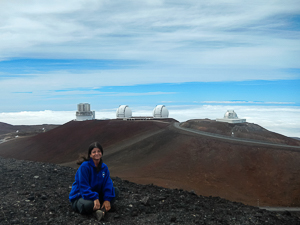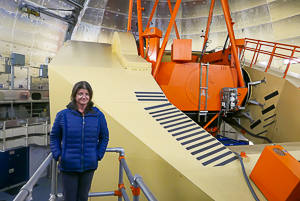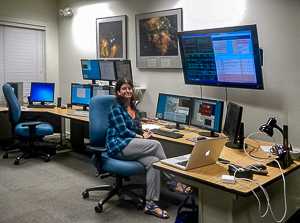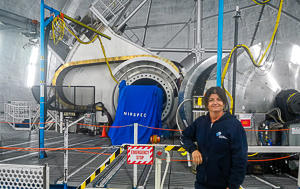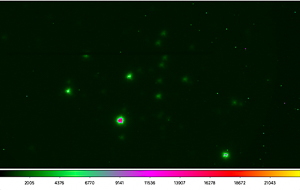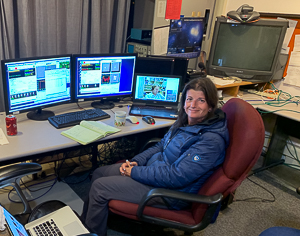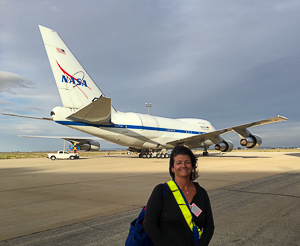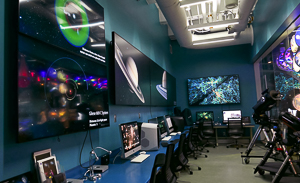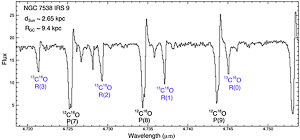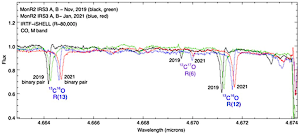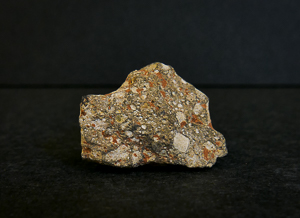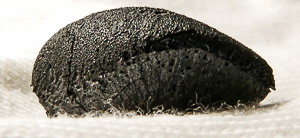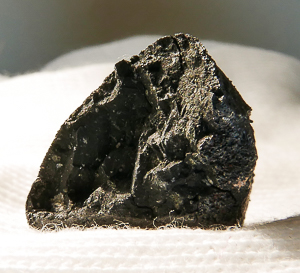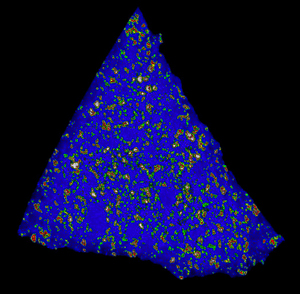Rachel Smith
Head, Astronomy & Astrophysics Research Lab and Curator, Meteorites
rachel.smith@naturalsciences.org
121 West Jones Street, Raleigh, NC 27601919.707.9384
Education
- PhD in Cosmochemistry/Astrochemistry (officially, Geochemistry), University of California Los Angeles, 2011
- MS in Cosmochemistry/Astrochemistry (officially, Geochemistry), University of California Los Angeles, 2009
- DVM, Cornell University, College of Veterinary Medicine, 1998
- BS, Cornell University, 1995
Appointments
- Professor, Department of Physics & Astronomy, Appalachian State University
- Adjunct Professor, Department of Physics and Astronomy, UNC at Chapel Hill
- (Past) Assistant Professor/Associate Professor, Department of Physics & Astronomy, Appalachian State University
- (Past) Postdoctoral Scholar, Astronomy/Astrochemistry/Planetary Science, Blake Research Group, California Institute of Technology, 2011
Awards
- (2025) 100 Scholars Research Award
- (2010) Gordon A. McKay Award, The Meteoritical Society
- (2009) Chambliss Astronomy Achievement Student Award, American Astronomical Society
- (2009) Career Development Award, Lunar and Planetary Institute
Curriculum Vitae
Research Interests
- Early solar system chemistry
- Chemistry of forming planetary systems in the Galaxy
- Solar system evolution and planet formation
- Life in the Universe
- Origin of life
Dr. Rachel Smith is an observational astronomer interested in how our solar system and other planetary systems form and evolve over time. She uses some of the largest ground-based optical-infrared telescopes, including the 10-meter Keck Observatory on Mauna Kea in Hawaii, to study the chemistry of protoplanetary material — the gas, ice, and dust that will eventually make up planets and pre-biotic compounds — that surrounds forming stars across the Galaxy. Dr. Smith uses a high-resolution spectrograph called NIRSPEC on the Keck II telescope to evaluate in detail the isotopes of carbon and oxygen in carbon monoxide gas (CO, the same molecule in car exhaust). This gas is abundant in protoplanetary systems, many of which are analogues to our solar system when it was forming ≈4.57 billion years ago.
Dr. Smith collaborates with scientists at the California Institute of Technology, Jet Propulsion Laboratory, Space Telescope Science Institute, NASA Ames, and the American Museum of Natural History.
Data from these observations can be compared to meteorites and the Sun — together, the oldest material we have from the early solar system — in order to understand the early chemical pathways fundamental toward building planets, and eventually, life.
Dr. Smith is currently analyzing a large dataset from young stars more massive than the Sun in order to learn more about how star and planet formation may vary in different environments across the Galaxy. She also recently flew on the Stratospheric Observatory for Infrared Astronomy as part of a project aimed at observing sulfur dioxide in massive young stars.
Dr. Smith is responsible for curating the Museum’s Meteorite Collection. She is currently working on building the collection, examining meteorites in thin section, as well as exploring other visualization tools.
View Meteorite Collection Database.
Additionally, she oversees the visual content of the Astronomy & Astrophysics Research Lab (AARL), and is currently part of an exciting project to create interactive programs and digital content using new open-source fly-through-the-universe software called OpenSpace. Development of this software is part of a NASA-funded collaboration with the American Museum of Natural History in New York City, and also includes other museum and institutional partners.
Dr. Smith teaches two undergraduate courses that she also developed for Appalachian State University: Astrobiology: Exploring Life in the Universe (spring/alternating fall semesters), and Star Formation (alternating fall semesters). These courses help introduce fundamental concepts that are at the core of astrophysics and space exploration, and the many facets of searching for life beyond Earth. Dr. Smith has several internships each summer aimed at motivated undergraduates interested in joining her research and/or outreach projects.
Courses Taught at Appalachian State University:
- Astrobiology: Searching for Life in the Universe (Spring/Alternating Fall)
- Star Formation (Alternating Fall)
Selected Publications
- Dungee, R., Boogert, A., de Witt, C., Monteil, C., Richter, M. J., Barr, A. G., Charnley, S., Indriolo, N., Karska, A., Neufeld, D. A., Smith, R. L., Tielens, A. G. G. M. High Resolution SOFIA/EXES Spectroscopy of SO2 Gas in the Massive Young Stellar Object MonR2 IRS3: Implications for the Sulfur Budget. The Astrophysical Journal Letters (SOFIA Special Focus issue), 868, L10.
[http://iopscience.iop.org/article/10.3847/2041-8213/aaeda9/meta] - Tillett A., Dermigny J., Emamian M., Tonin Y., Bucay I., Smith R. L., Darken M., Dearing C., Orbon M., Iliadis C. (2017). A low-background ϒϒ-coincidence spectrometer for radioisotope studies. Nuclear Inst. and Methods in Physics Research A 871, 66.
[https://www.sciencedirect.com/science/article/pii/S016890021730829X?via%3Dihub] - Smith R. L., Pontoppidan K. M., Young E. D. and Morris M. R. (2015) Heterogeneity in
12CO/13CO abundance ratios toward solar-type young stellar objects. The Astrophysical Journal
813, 16 pp.
[http://iopscience.iop.org/article/10.1088/0004-637X/813/2/120/pdf] - Young E. D., Gounelle M., Smith R. L., Pontoppidan K. M., and Morris M. R., (2011).
Astronomical oxygen isotopic evidence for supernova enrichment of the solar system birth
environment by propagating star formation. The Astrophysical Journal 729, 13 pp.
[http://iopscience.iop.org/article/10.1088/0004-637X/729/1/43/pdf] - Smith R. L., Pontoppidan K. M., Young E. D., Morris M. R. and van Dishoeck E. F. (2009)
High-precision C17O, C18O and C16O measurements in young stellar objects: analogues for CO
self- shielding in the early solar system. The Astrophysical Journal 701, 13 pp.
[http://iopscience.iop.org/article/10.1088/0004-637X/701/1/163/pdf]
Online Resources and Publications
OpenSpace, fly-through-the-Universe software
Dr. Smith is a collaborator and co-investigator on the NASA-funded project, OpenSpace: An Engine for Dynamic Visualization of Earth and Space Science for Informal Education and Beyond, led by the American Museum of Natural History in New York City. The project team is developing an open-source software tool called OpenSpace: http://openspaceproject.com
The Most Unknown, science documentary (2018)
Rachel is one of nine scientists featured in "The Most Unknown," a documentary produced by VICE Motherboard and the Simons Foundation premiered in 2018.
Resources
- Film site: https://www.themostunknown.com
- Netflix: https://www.netflix.com/title/80222042
- VICE: https://motherboard.vice.com/en_us/article/wj44gz/watch-the-trailer-for-the-most-unknown-motherboards-first-feature-documentary
- Official trailer: https://vimeo.com/258144049
Press
- Variety: http://variety.com/2018/digital/news/netflix-vice-motherboard-most-unknown-documentary-theatrical-1202764193/
- The New Yorker: https://www.newyorker.com/recommends/watch/the-most-unknown
- Los Angeles Times: http://www.latimes.com/entertainment/movies/la-et-mn-capsule-the-most-unknown-review-20180524-story.html
- Movie Nation: https://rogersmovienation.com/2018/05/10/movie-review-scientists-learn-the-most-unknown-in-each-others-disciplines-in-new-documentary/
- Science Sandbox: https://www.simonsfoundation.org/2018/02/23/the-most-unknown-selected-to-open-major-film-festival/
- Appalachian State University: https://today.appstate.edu/2018/06/08/the-most-unknown
- Simons Foundation: https://www.simonsfoundation.org/
Selected Published Conference Proceedings
- Smith, R.L., Blake, G. A., Boogert, A.C.A., Pontoppidan, Tucker, M. A. (2018) An Observational Study of Protoplanetary Carbon from the Galactic Center to the Local Solar Neighborhood, 49th Lunar and Planetary Science Conference, The Woodlands, TX, LPI 2083, 2985.
[https://www.hou.usra.edu/meetings/lpsc2018/pdf/2985.pdf] - Smith, L. R. (undergraduate), Panto, E. M. (undergraduate), Gudipati, M. S., Smith, R. L. (2018) Exploring 12CO/13CO Ice-Gas Fractionation Through Interstellar Ice-Analogue Experiments, 49th Lunar and Planetary Science Conference, The Woodlands, TX, LPI 2083, 1187.
[https://www.hou.usra.edu/meetings/lpsc2018/pdf/1187.pdf] - Crapster-Pregont, E. J., Gemma, M. E., Emmart, C., Trakinski, Smith, R. L., Ebel, D. S., Kinzler, R. (2018) Setting the Universe Free, 49th Lunar and Planetary Science Conference, The Woodlands, TX, LPI 2083, 2111.
[https://www.hou.usra.edu/meetings/lpsc2018/pdf/2111.pdf] - Smith, R.L., Blake, G. A., Boogert, A.C.A., Pontoppidan (2017) An Observational Survey of Protoplanetary Carbon in Young Stellar Systems Across the Galaxy, 80th Annual Meeting of the Meteoritical Society, Santa Fe, New Mexico, LPI 1987, 6174.
[https://www.hou.usra.edu/meetings/metsoc2017/pdf/6174.pdf] - Smith, R. L., Blake, G. A., Boogert, A.C.A., Pontoppidan, K. M., Lockwood, A. C. (2016)
High-Resolution Observations of CO Toward Massive Young Stellar Objects: Investigations of
Protoplanetary Carbon and Oxygen in the Galaxy, 47th Lunar and Planetary Science Conference.
[http://www.hou.usra.edu/meetings/lpsc2016/pdf/3028.pdf] - Smith, R.L., Blake, G. A., Boogert, A.C.A., Pontoppidan, K. M., Lockwood, A. C. (2014). Investigating
Protostellar Carbon Reservoirs with High-Resolution Spectroscopy Toward Massive Young Stellar Objects. 77th
Meteoritical Society Meeting, Casablanca, Morocco, LPI, No. 1800, p. 5435.
[https://www.hou.usra.edu/meetings/metsoc2014/pdf/5435.pdf] - Smith, R.L., Pontoppidan, K. M., Blake, G. A., Lockwood, A. C., 2013. Observations of carbon and oxygen isotopic
heterogeneity toward protostars ranging in morphology and parent cloud. 44th Lunar and Planetary Science Conference, The Woodlands, TX, LPI, No.1719, p. 2698.
[http://www.lpi.usra.edu/meetings/lpsc2013/pdf/2698.pdf] - Smith, R.L., Pontoppidan, K. M., Young, E. D., and Morris, M. R. (2010) New 12CO/13CO observations in young stellar objects and molecular clouds: implications for 12C/13C in the early solar nebula. 73rd Meteoritical Society Meeting, New York City, NY, Meteoritics & Planetary Science (Supplement), id. 5381.
[https://www.lpi.usra.edu/meetings/metsoc2010/pdf/5381.pdf]
Won the Gordon A. McKay Award [http://meteoriticalsociety.org/?page_id=64].


